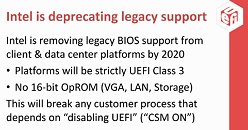- Joined
- Oct 9, 2007
- Messages
- 47,885 (7.38/day)
- Location
- Dublin, Ireland
| System Name | RBMK-1000 |
|---|---|
| Processor | AMD Ryzen 7 5700G |
| Motherboard | Gigabyte B550 AORUS Elite V2 |
| Cooling | DeepCool Gammax L240 V2 |
| Memory | 2x 16GB DDR4-3200 |
| Video Card(s) | Galax RTX 4070 Ti EX |
| Storage | Samsung 990 1TB |
| Display(s) | BenQ 1440p 60 Hz 27-inch |
| Case | Corsair Carbide 100R |
| Audio Device(s) | ASUS SupremeFX S1220A |
| Power Supply | Cooler Master MWE Gold 650W |
| Mouse | ASUS ROG Strix Impact |
| Keyboard | Gamdias Hermes E2 |
| Software | Windows 11 Pro |
Intel is guiding its motherboard partners to remove legacy BIOS support from their UEFI firmware by 2020. The company's client- and enterprise-platforms that come out in 2020 will lack CSM (compatibility support module), a component which lets UEFI-unaware operating systems and bootable devices run on newer machines with UEFI. Devices featuring this CSM-devoid runtime will be graded "UEFI Class 3," as the runtime only exposes UEFI or UEFI PI interfaces.
This practically marks the end of 32-bit operating systems on the newer machines, as 32-bit Windows and desktop Linux distributions require CSM. You'll still be able to use 32-bit software running on 64-bit Windows through WoW64 translation layers. The lack of CSM will also affect devices with 16-bit OpROM, such as older network adapters, and older RAID HBAs. You'll have to depend on OS-based programs to configure those devices. Newer versions of Windows Secure Boot will require UEFI Class 3 devices to function. This also affects booting with your main display plugged into graphics cards older than 4 years (launched roughly before 2013), which lack UEFI-ready video BIOS.



View at TechPowerUp Main Site
This practically marks the end of 32-bit operating systems on the newer machines, as 32-bit Windows and desktop Linux distributions require CSM. You'll still be able to use 32-bit software running on 64-bit Windows through WoW64 translation layers. The lack of CSM will also affect devices with 16-bit OpROM, such as older network adapters, and older RAID HBAs. You'll have to depend on OS-based programs to configure those devices. Newer versions of Windows Secure Boot will require UEFI Class 3 devices to function. This also affects booting with your main display plugged into graphics cards older than 4 years (launched roughly before 2013), which lack UEFI-ready video BIOS.



View at TechPowerUp Main Site
Last edited:





